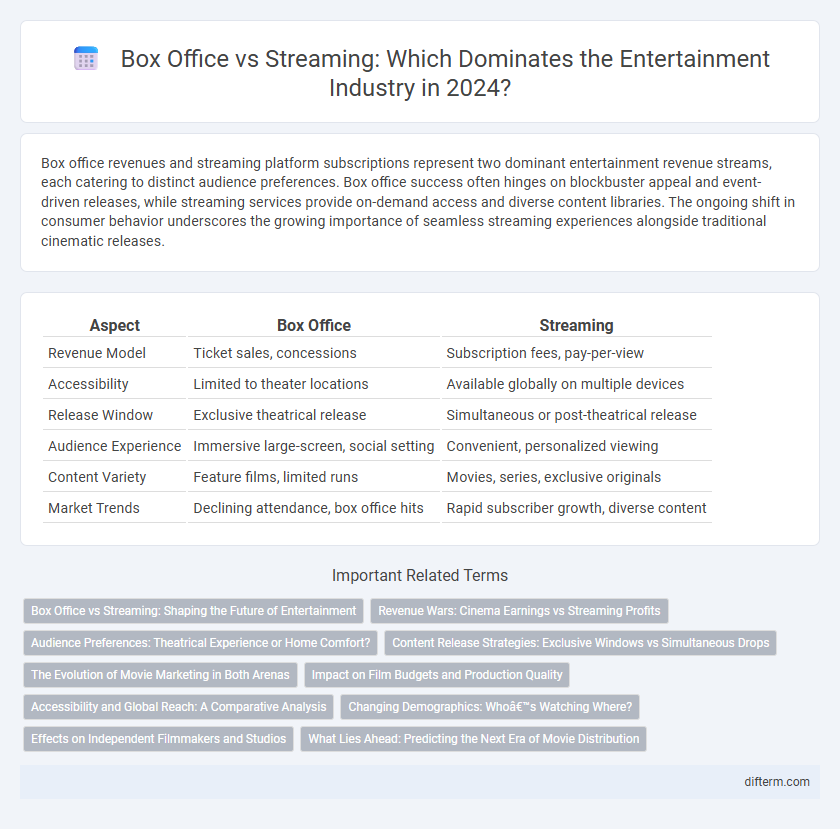Box office revenues and streaming platform subscriptions represent two dominant entertainment revenue streams, each catering to distinct audience preferences. Box office success often hinges on blockbuster appeal and event-driven releases, while streaming services provide on-demand access and diverse content libraries. The ongoing shift in consumer behavior underscores the growing importance of seamless streaming experiences alongside traditional cinematic releases.
Table of Comparison
| Aspect | Box Office | Streaming |
|---|---|---|
| Revenue Model | Ticket sales, concessions | Subscription fees, pay-per-view |
| Accessibility | Limited to theater locations | Available globally on multiple devices |
| Release Window | Exclusive theatrical release | Simultaneous or post-theatrical release |
| Audience Experience | Immersive large-screen, social setting | Convenient, personalized viewing |
| Content Variety | Feature films, limited runs | Movies, series, exclusive originals |
| Market Trends | Declining attendance, box office hits | Rapid subscriber growth, diverse content |
Box Office vs Streaming: Shaping the Future of Entertainment
Box office revenue remains a critical benchmark for blockbuster success, with global earnings exceeding $42 billion in 2023, underscoring its continued dominance in theatrical experiences. In contrast, streaming platforms like Netflix and Disney+ have seen subscriber numbers surpass 500 million worldwide, signaling a seismic shift in content consumption towards on-demand accessibility. The convergence of big-budget theatrical releases and exclusive streaming premieres is redefining distribution models, leveraging both box office grosses and digital subscriptions to shape the future of entertainment.
Revenue Wars: Cinema Earnings vs Streaming Profits
Cinema box office revenue, traditionally dominating the entertainment industry, faces significant competition from streaming platforms that generate billions through subscription models and exclusive releases. Major studios report fluctuating box office earnings due to pandemic impacts, while platforms like Netflix and Disney+ continuously expand their subscriber bases, driving substantial direct-to-consumer profits. This shift underscores a revenue war where theatrical releases coexist with streaming services, redefining profit strategies and audience engagement worldwide.
Audience Preferences: Theatrical Experience or Home Comfort?
Audiences display a dynamic preference battle between the immersive theatrical experience and the convenience of home streaming. Box office revenues surged with blockbuster releases, highlighting demand for cinematic spectacle and social viewing. Streaming platforms gain momentum due to personalized content libraries, ease of access, and comfort, reshaping entertainment consumption habits globally.
Content Release Strategies: Exclusive Windows vs Simultaneous Drops
Content release strategies in entertainment increasingly weigh exclusive theatrical windows against simultaneous streaming and cinema drops, profoundly impacting box office revenues and subscriber engagement. Exclusive windows create scarcity that can drive higher box office sales by encouraging audiences to experience films in theaters first, while simultaneous drops fulfill consumer demand for instant access, boosting streaming platform subscriptions and viewer numbers. Data from major studios show that films with exclusive theatrical releases typically command greater total revenue through ticket sales, though simultaneous releases often expand overall audience reach and long-term platform value.
The Evolution of Movie Marketing in Both Arenas
Movie marketing has evolved significantly with the rise of box office and streaming platforms, integrating traditional trailers and in-theater promotions with targeted social media campaigns and personalized digital ads. Studios now leverage real-time analytics and viewer data from streaming services to refine marketing strategies and maximize audience engagement. This hybrid approach enhances visibility across multiple channels, driving revenue growth for theatrical releases and streaming premieres alike.
Impact on Film Budgets and Production Quality
The rise of streaming platforms has shifted film budgets, often prioritizing smaller-scale productions with tighter financial constraints compared to traditional box office releases. High-budget theatrical films invest heavily in visual effects and star talent to maximize cinematic appeal, while streaming projects allocate funds toward diverse content and innovative storytelling techniques that cater to niche audiences. This shift influences production quality, balancing blockbuster spectacle against creative risk-taking fueled by streaming's flexible distribution models.
Accessibility and Global Reach: A Comparative Analysis
Streaming platforms offer unparalleled accessibility by allowing instant content consumption across multiple devices without geographic restrictions, significantly expanding global reach. Box office releases, while generating high local engagement and cultural event status, face limitations in availability due to theater locations and showtimes, restricting audience access. The comparative advantage of streaming lies in its ability to deliver diverse, on-demand content worldwide, democratizing entertainment access beyond traditional cinema constraints.
Changing Demographics: Who’s Watching Where?
Changing demographics reveal a significant shift in entertainment consumption, with younger audiences predominantly favoring streaming platforms such as Netflix and Disney+ over traditional box office theaters. Data from Nielsen indicates that 68% of viewers aged 18-34 prefer on-demand streaming, driven by convenience and wider content variety. Conversely, older demographics continue to support theatrical releases, highlighting a generational divide in viewing habits that influences content distribution strategies.
Effects on Independent Filmmakers and Studios
Independent filmmakers face unique challenges as box office revenues decline and streaming platforms dominate distribution, often resulting in reduced theatrical opportunities but expanded access to global audiences. Streaming services offer independent studios alternative avenues for financing, marketing, and audience engagement, enabling niche content to find dedicated viewers beyond traditional cinema limits. However, the shift affects revenue models and creative control, with many smaller studios navigating complex licensing agreements and profit-sharing structures in the digital marketplace.
What Lies Ahead: Predicting the Next Era of Movie Distribution
The future of movie distribution hinges on a hybrid model where box office revenue coexists with expanding streaming platforms, driven by evolving consumer preferences and technological advancements. Data from recent market trends indicates that while theatrical releases generate significant initial revenue, streaming services are capturing a growing global audience through convenience and exclusive content. Predictive analytics suggest that studios will increasingly adopt simultaneous release strategies, leveraging both mediums to maximize reach and profitability in the next era of entertainment distribution.
box office vs streaming Infographic

 difterm.com
difterm.com